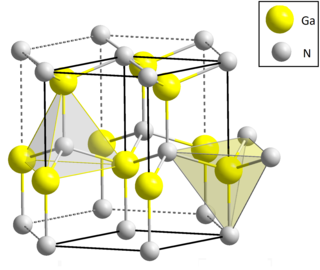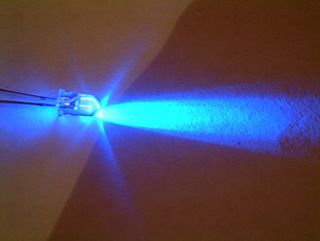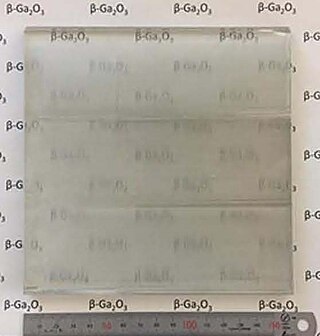Related Research Articles

Epitaxy refers to a type of crystal growth or material deposition in which new crystalline layers are formed with one or more well-defined orientations with respect to the crystalline seed layer. The deposited crystalline film is called an epitaxial film or epitaxial layer. The relative orientation(s) of the epitaxial layer to the seed layer is defined in terms of the orientation of the crystal lattice of each material. For most epitaxial growths, the new layer is usually crystalline and each crystallographic domain of the overlayer must have a well-defined orientation relative to the substrate crystal structure. Epitaxy can involve single-crystal structures, although grain-to-grain epitaxy has been observed in granular films. For most technological applications, single domain epitaxy, which is the growth of an overlayer crystal with one well-defined orientation with respect to the substrate crystal, is preferred. Epitaxy can also play an important role while growing superlattice structures.

Molecular-beam epitaxy (MBE) is an epitaxy method for thin-film deposition of single crystals. MBE is widely used in the manufacture of semiconductor devices, including transistors, and it is considered one of the fundamental tools for the development of nanotechnologies. MBE is used to fabricate diodes and MOSFETs at microwave frequencies, and to manufacture the lasers used to read optical discs.

Gallium nitride is a binary III/V direct bandgap semiconductor commonly used in blue light-emitting diodes since the 1990s. The compound is a very hard material that has a Wurtzite crystal structure. Its wide band gap of 3.4 eV affords it special properties for applications in optoelectronic, high-power and high-frequency devices. For example, GaN is the substrate which makes violet (405 nm) laser diodes possible, without requiring nonlinear optical frequency-doubling.

A quantum well is a potential well with only discrete energy values.
In chemistry, a nitride is an inorganic compound of nitrogen. The "nitride" anion, N3- ion, is very elusive but compounds of nitride are numerous, although rarely naturally occurring. Some nitrides have a found applications, such as wear-resistant coatings (e.g., titanium nitride, TiN), hard ceramic materials (e.g., silicon nitride, Si3N4), and semiconductors (e.g., gallium nitride, GaN). The development of GaN-based light emitting diodes was recognized by the 2014 Nobel Prize in Physics. Metal nitrido complexes are also common.

Indium nitride is a small bandgap semiconductor material which has potential application in solar cells and high speed electronics.
An epitaxial wafer is a wafer of semiconducting material made by epitaxial growth (epitaxy) for use in photonics, microelectronics, spintronics, or photovoltaics. The epi layer may be the same material as the substrate, typically monocrystaline silicon, or it may be a silicon dioxide (SoI) or a more exotic material with specific desirable qualities. The purpose of epitaxy is to perfect the crystal structure over the bare substrate below and improve the wafer surface's electrical characteristics, making it suitable for highly complex microprocessors and memory devices.
Indium gallium arsenide (InGaAs) is a ternary alloy of indium arsenide (InAs) and gallium arsenide (GaAs). Indium and gallium are group III elements of the periodic table while arsenic is a group V element. Alloys made of these chemical groups are referred to as "III-V" compounds. InGaAs has properties intermediate between those of GaAs and InAs. InGaAs is a room-temperature semiconductor with applications in electronics and photonics.

Indium gallium nitride is a semiconductor material made of a mix of gallium nitride (GaN) and indium nitride (InN). It is a ternary group III/group V direct bandgap semiconductor. Its bandgap can be tuned by varying the amount of indium in the alloy. InxGa1−xN has a direct bandgap span from the infrared for InN to the ultraviolet of GaN. The ratio of In/Ga is usually between 0.02/0.98 and 0.3/0.7.
Aluminium gallium nitride (AlGaN) is a semiconductor material. It is any alloy of aluminium nitride and gallium nitride.

Gallium(III) oxide is an inorganic compound and ultra-wide-bandgap semiconductor with the formula Ga2O3. It is actively studied for applications in power electronics, phosphors, and gas sensing. The compound has several polymorphs, of which the monoclinic β-phase is the most stable. The β-phase’s bandgap of 4.7–4.9 eV and large-area, native substrates make it a promising competitor to GaN and SiC-based power electronics applications and solar-blind UV photodetectors. The orthorhombic ĸ-Ga2O3 is the second most stable polymorph. The ĸ-phase has shown instability of subsurface doping density under thermal exposure. Ga2O3 exhibits reduced thermal conductivity and electron mobility by an order of magnitude compared to GaN and SiC, but is predicted to be significantly more cost-effective due to being the only wide-bandgap material capable of being grown from melt. β-Ga2O3 is thought to be radiation-hard, which makes it promising for military and space applications.

Isamu Akasaki was a Japanese engineer and physicist, specializing in the field of semiconductor technology and Nobel Prize laureate, best known for inventing the bright gallium nitride (GaN) p-n junction blue LED in 1989 and subsequently the high-brightness GaN blue LED as well.
Gallium manganese arsenide, chemical formula (Ga,Mn)As is a magnetic semiconductor. It is based on the world's second most commonly used semiconductor, gallium arsenide,, and readily compatible with existing semiconductor technologies. Differently from other dilute magnetic semiconductors, such as the majority of those based on II-VI semiconductors, it is not paramagnetic but ferromagnetic, and hence exhibits hysteretic magnetization behavior. This memory effect is of importance for the creation of persistent devices. In (Ga,Mn)As, the manganese atoms provide a magnetic moment, and each also acts as an acceptor, making it a p-type material. The presence of carriers allows the material to be used for spin-polarized currents. In contrast, many other ferromagnetic magnetic semiconductors are strongly insulating and so do not possess free carriers. (Ga,Mn)As is therefore a candidate as a spintronic material.
A quantum well laser is a laser diode in which the active region of the device is so narrow that quantum confinement occurs. Laser diodes are formed in compound semiconductor materials that are able to emit light efficiently. The wavelength of the light emitted by a quantum well laser is determined by the width of the active region rather than just the bandgap of the materials from which it is constructed. This means that much shorter wavelengths can be obtained from quantum well lasers than from conventional laser diodes using a particular semiconductor material. The efficiency of a quantum well laser is also greater than a conventional laser diode due to the stepwise form of its density of states function.

Hiroshi Amano is a Japanese physicist, engineer and inventor specializing in the field of semiconductor technology. For his work he was awarded the 2014 Nobel Prize in Physics together with Isamu Akasaki and Shuji Nakamura for "the invention of efficient blue light-emitting diodes which has enabled bright and energy-saving white light sources".
Indium aluminium nitride (InAlN) is a direct bandgap semiconductor material used in the manufacture of electronic and photonic devices. It is part of the III-V group of semiconductors, being an alloy of indium nitride and aluminium nitride, and is closely related to the more widely used gallium nitride. It is of special interest in applications requiring good stability and reliability, owing to its large direct bandgap and ability to maintain operation at temperatures of up to 1000 °C., making it of particular interest to areas such as the space industry. InAlN high-electron-mobility transistors (HEMTs) are attractive candidates for such applications owing to the ability of InAlN to lattice-match to gallium nitride, eliminating a reported failure route in the closely related aluminium gallium nitride HEMTs.

Rachel Angharad Oliver is a Professor of Materials Science at the University of Cambridge and a fellow of Robinson College, Cambridge. She works on characterisation techniques for gallium nitride materials for light-emitting diodes and laser diodes.
Diana Huffaker FIEEE, FOSA is a physicist working in compound semiconductors optical devices. She is the current Sêr Cymru Chair in Advanced Engineering and Materials and Science Director of the Institute of Compound Semiconductors is based within Cardiff University. Her work includes compound semiconductor epitaxy, lasers, solar cells, optoelectronic devices, plasmonics, and Quantum dot and nanostructured materials.

Jagdish Narayan is an Indian-born American engineer. Since 2001, he has been the John C. C. Fan Family Distinguished Chair Professor in the Materials Science and Engineering Department at North Carolina State University. He is also the distinguished visiting scientist at Oak Ridge National Laboratory. Narayan has published above 500 high-impact journal articles, with his discoveries covered in over 40 US and international patents. His body of work can be segregated into highly non-equilibrium laser processing of novel nanomaterials, including Q-carbon, Q-BN, diamond and c-BN related materials. These research articles have received over 31,000 Google citations with h-index >85. Narayan and his students discovered Q-carbon asa new allotrope, thereby finding a new route to fabricate diamond and related materials in ambient conditions, resulting in properties and applications ranging from high-temperature superconductivity in boron-doped Q-carbon to hardness than diamond in Q-carbon to enhanced field-emission in Q-carbon to nitrogen-doped nanodiamonds for quantum computing, nanosensing and solid-state devices.
References
- ↑ "Nicolas Grandjean". Google Scholar . Retrieved October 29, 2016.
- ↑ Florence Luy (December 10, 2009). "Nicolas Grandjean: Appointed Full Professor". École Polytechnique Fédérale de Lausanne. Retrieved December 27, 2013.
- ↑ B. Damilano; Nicolas Grandjean; F. Semond; J. Massies; M. Leroux (June 18, 2009). "From visible to white light emission by GaN quantum dots on Si(111) substrate". Applied Physics Letters . 75 (7): 962–964. Bibcode:1999ApPhL..75..962D. doi:10.1063/1.124567.
- ↑ Nicolas Grandjean; J. Massies; M. Leroux (June 18, 2009). "Nitridation of sapphire. Effect on the optical properties of GaN epitaxial overlayers". Applied Physics Letters. 69 (14): 2071–2073. Bibcode:1996ApPhL..69.2071G. doi:10.1063/1.116883.
- ↑ B. Damilano; Nicolas Grandjean; S. Dalmasso; J. Massies (June 18, 2009). "Room-temperature blue-green emission from InGaN/GaN quantum dots made by strain-induced islanding growth". Applied Physics Letters. 75 (24): 751–3753. Bibcode:1999ApPhL..75.3751D. doi:10.1063/1.125444.